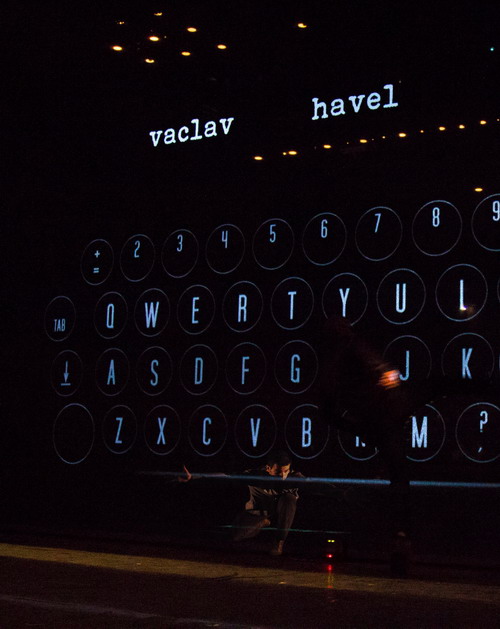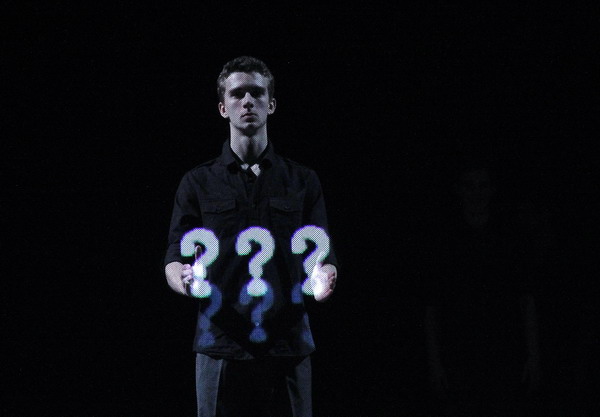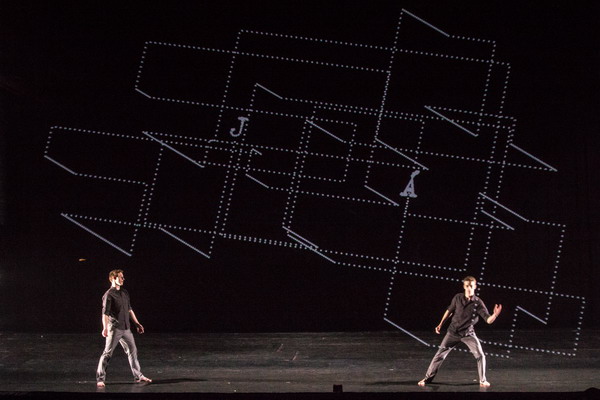 Laterna Magika has staged yet another brand new production in this theatre season. After a family oriented piece comes a production inspired by literature and associated with multimedia project, which should prove that the company once regarded as innovators in the theatre world are still very much capable of fresh artistic output. The production Anticodes, premiered on March 21st, 2013 at the New Stage of the National Theatre is inspired by the visual poetry of Václav Havel, which is transformed into a dance-movement performance, in which the dancers find themselves in contact with an interactive technology and every repeat will thus occur in real time with all audiovisual features. The production is directed by an experienced author Braňo Mazúch, for whom it is his first collaboration with the National Theatre, however, he has already created several successful productions both in the Czech Republic and abroad. Will he and his team succeed in breathing new life into the Laterna Magika trademark? We have discussed the creative process and some of the problems that went with it.
Laterna Magika has staged yet another brand new production in this theatre season. After a family oriented piece comes a production inspired by literature and associated with multimedia project, which should prove that the company once regarded as innovators in the theatre world are still very much capable of fresh artistic output. The production Anticodes, premiered on March 21st, 2013 at the New Stage of the National Theatre is inspired by the visual poetry of Václav Havel, which is transformed into a dance-movement performance, in which the dancers find themselves in contact with an interactive technology and every repeat will thus occur in real time with all audiovisual features. The production is directed by an experienced author Braňo Mazúch, for whom it is his first collaboration with the National Theatre, however, he has already created several successful productions both in the Czech Republic and abroad. Will he and his team succeed in breathing new life into the Laterna Magika trademark? We have discussed the creative process and some of the problems that went with it.What is the importance of dance in the production that you have directed? As an author, when did you encounter dance for the first time?
Well, the first time I have collaborated on a dance production as such was in 1993, when I studied at the Academy of Performing Arts. The piece was called A Party at Leobil and was performed at the Roxy club under the movement supervision of Jaroslava Hojtašová. Basically, it was a collection of movement improvisations on themes from poems by various authors. At the school I was influenced by a workshop with Lech Raczak, founder of the Polish Theatre of the Eighth Day and workshops of African expressive dance led by French choreographer Nizouchy. I perceive movement as perhaps the most important theatrical means of expression of an actor, or, more precisely, of a performer.
Do you have your say in the creation of choreography?
The most important issue is a formulation of the theme and defining the shape of the production. On the basis of these the choice of choreographer is made, but of course not just this choice. Then I let the people in my team do their work, which of course includes the choreography as well. If the starting point of the production is clearly defined, it is not necessary
 to adjust the work of individual sections that much.
to adjust the work of individual sections that much.Laterna Magika is indeed a world-famous name, but a lot of people see it rather as an attraction or a relic of the past. Do you see a future in this type of theatre?
Well, there is definitely a future in the relation with multimedia. Now it is essential that Laterna Magika, or the New Stage of the National Theatre create opportunities for regular work for new authors who can offer new experiences. And not just once in five years, because development of multimedia goes forward quickly. It would be perfect if every year several such attempts as Anticodes were created, using new technological features and scope for their testing. I think that even in the Czech Republic partners for such projects may not be so difficult to find as the technology for Anticodes has been provided by a Czech company AV Media. Moreover, I would not hesitate to call a lot of artists from this field multimedia do-it-yourself guys who are able to come up with their own original and effective solutions. Do you think this is a mistake of dramaturgy then?
I would not call it a mistake. The concept of Laterna Magika was clearly defined at the very beginning, now it seems to be shifting and opening to new impulses. Last summer the dramaturgy of the New Stage came up with the challenge of staging Anticodes and whereas this collection of visual poetry of Václav Havel represents the experimental poetry of the 20th century, we would like to see our production pave the way for experimental production of Laterna Magika in the 21st century. It's an opportunity to employ in the creative process things that have been part of the stage practice in France, Germany and other countries for several decades. In the Western Europe new media have become (or are about to become) a common part of performances and productions.
Still, we should not forget the issue of a limited budget ...
Sure, new media are expensive, but as I said, some companies venture into this realm because they see an opportunity to present their technology in a context other than just the commercial one. Theatre becomes a promoter of new technologies and can show new ways a particular technology could be used. Airscan, which is an essential part of Anticodes thus may be not only the scanning device installed on toll gates on the highway, it can also have a much more poetic function. Nevertheless, I do not claim that in our production we worked with the latest technology. Together with Dan Gregor, Standa Abrahám and Věrka Ondrašíková we just try to find new ways of employing whatever is available to us. Even though the things abroad have moved a little further in the meantime.
In Anticodes there is a character of a writer who reflects on his past life, both the creative and the personal one, his ideas and visions come to life ... Could you specify what the idea was?
It is a reflection of the world, of the society and people that are part of it, there are personal memories, reflections on a creative process, political considerations, social criticism and so on. One of the main themes in typograms is the man, his or her character, temperament, ambitions, dreams, memories, ideas and desires. Through the man a reflection of society and its manifestations take place, such as personality cult, totalitarianism, freedom of speech and so on.
Does the production somehow relate to the present day as well? Considering the collection originated in the context of the sixties, is it possible at all?
Topics in the collection and their visual reflections and interpretations are timeless. For instance, if we take the theme of "man", his or her charater manifests itself the same way, be it in the 60s, 70s or 80s. After all, we see the same characters even after the Velvet Revolution, only the background has changed. For our production we have chosen from the whole collection primarily those typograms, which thematically resonate with the present day. There's obviously a reflection on the life of Václav Havel too, there is a theme of creation and its principles, some intimate topics, but also, as I already mentioned, the personality cult, manipulation with words. As for the abuse of language – although in a different way than in the 60s – it very much happens these days too, just think about the power of media and market. Anticodes get to the very essence of a word, of a concept and its contents, from which they chip off all uneccesary things and manipulative deformation. And that is what makes them up to date.
On the stage, Havel’s typograms come to life by the means of interactive technology, everything depends on the contact between the dancers and technology. What happens if a dancer makes a mistake?
Well, he will have to rectify it then. All is about an interactive interplay in real time, so the dancer can respond live to mistakes too. At this point I would like to say that not always a copy of the original typogram has been created. We were looking for different ways of staging individual typograms, in some cases a typogram was paraphrased, sometimes it was a very loose inspiration, melting into the choreography. Therefore it is not about just one principle and technology from the beginning to the end. They are alternated according to content, according to their place in the structure of production, but also according to the possibilities the technology offers in terms of their transformation to a scenic form.
How important is the role of Standa Abrahám, who impersonates the writer on
 the stage?
the stage?With Václav Havel’s typograms, we see not only the carefulness he laboriously generated them on his typewriter with, but also his playfulness, imagination and precision. And these were the defining characteristics of the role of a writer-performer for us too. Moreover, in the case of Standa Abrahám, these characteristics are applicable also to sound design, which is created live to a certain extent. We often see playfulness as the most important aspect of visual poetry, anyway, wouldn’t it be tempting to examine the content to more depth? Could this be the case of Václav Havel’s poetry?
Well, unlike Dadaists and their visual poetry for instance, Václav Havel’s Anticodes, as I mentioned, possess philosophical and existential qualities. This is what makes them interesting and still very much up-to-date, the very fact that they go into depth of both serious issues and the contents of words, the fact that they are not just about playfulness as such, but rather about playful analysis of a particular social situation.
Anticodes were commissioned by the New Stage, however, it was you who put together the creative team.
Indeed, the requirement to use multimedia was part of the assignment. As for the team, the choice of particular artists was quite an obvious one, because I had previously worked with Věrka Ondrašíková, who had been experimenting with multimedia for years and looking constantly for new principles of integration of new technologies into her work. Similarly, I had already known Dan Gregor, who has dedicated himself to mapping and interactivity. Thanks to Věrka I also met Standa Abrahám, so for my team I could choose people who had had rich experience with multimedia already. As for myself, this was my very first experience in this field.
What does your encounter with multimedia mean to you in this context?
To me it is definitely a challenge. In some situations I was pleasantly surprised by what the technology has to offer, sometimes it was actually a bit of a shock therapy. I am getting familiar with the various features that multimedia and technologies offer, and what I like on top of that is minimalism. So little is needed to express an idea, for example, a beam of light that follows the movement of a dancer. Are you afraid that the growing fascination with technologies might prevail over the human factor?
Not really, after all I see that the more possibilities there are, the more new companies, new perspectives and new ways of visual expression come into being. I think that the ambition of each author is to express his or her idea rather than just show that a particular technology can do something really great. Everyone has his or her own theme that he or she strives to develop, and the technology is just the means of doing it.
Could you please tell us on which production you have been working with Věrka Ondrašíková?
The piece was called A Lover's Discourse: Fragments by Roland Barthes, it was featured at the Ponec theatre several years ago. As a matter of coincidence, this piece is scheduled to appear the next season on the stage of Divadlo bez zábradlí as Miluji tě, adapted and directed by J.A. Pitínský. We took Barthes’ text as a framework for our production and employed motives of other literary and dramatic works in it as well.
How long did it take to mount Anticodes? You mentioned that the production had been commissioned in summer, which is not that much time for a project in a big theatre.
Well, the initial commission came in June, together with Dan Gregor we created a concept and in July we learned that we would have the opportunity to stage it. Some time in September or October Dan began his work on sketching, or rather preprogramming some of the typograms. In January we started to work on choreography. Naturally, with this kind of projects every extra month is a benefit to you, it would have been perfect to have, say, a year or so to explore all the technological features and come to the final shape. What we see now is a rather condensed output. In fact, the New Stage presents Anticodes as an experiment, not as a production that should necessarily have a fixed final form on the opening night and that should run in this fixed form ever after. The principle of its interactivity alone makes it an open form, or rather, a work in progress. Due to technologies such as realtime tracking and so on a significant part of the performance will be variable. A performer has the freedom to work with time and meaning, with the very form of individual typograms. Naturally, we can still brush up on the piece and improve the employment of technologies. If we find that we have not chosen the best way, we will seek a new one. It is for sure that we want to meet over this piece and improve on some parts for future repeats.
What should the audiences expect from this production – a dramaturgical arc or a kaleidoscope of impressions?
If I had to use the word kaleidoscope, I would prefer a kaleidoscope of images then, but I will be glad if a spectator finds a dramaturgical line in it too. We definitely do not want this piece to be just one image next to another, but rather a complex structure that contributes to something factual. What it is has been actually mentioned several times in this interview. Braňo Mazúch
He studied stage direction at the Department of Alternative and Puppet Theatre at the Prague Academy of Performing Arts. Since his graduation in 1997 he has worked in many theatres in the Czech Republic and abroad. Many productions were created in Cheb, where he worked for several seasons as an artistic director (W. Shakespeare: The Tempest, J.W. Goethe: Urfaust, M. Maeterlinck: The Blue Bird, N. Machiavelli: Mandragora and others). These were followed for instance by Schiller's Maid of Orleans and Shakespeare’s Love’s Labour’s Lost in Hradec Králové, Seneca's Medea, Drábek’s Aquabelles and other productions staged in various Polish theatres etc.




Josef Bartos
Thank you for your thoughts. One got stuck in my mind – that passion makes us different from AI. Just yesterday I read…I am a dance critic. I am a member of an endangered species